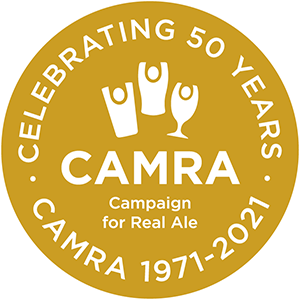Margaret Catchpole
Suffolk - Ipswich
Three star - A pub interior of outstanding national historic importance
Listed Status: II*
Cliff LaneIpswich
IP3 0PQ
OS ref: TM176432
Tel: (01473) 252450
Facebook https://www.facebook.com/604794719914662
Real Ale: Yes
Nearby Station: Derby Road (Ipswich)
Station Distance: 965m
Public Transport: Near Railway Station (Derby Road (Ipswich)) and Bus Stop
Bus: Yes
View on: Whatpub
Arguably the finest surviving 1930s pub in all England, displaying a glorious combination of quality and intactness (and listed at Grade II* as a consequence)
Built in 1936 for a housing estate, this precious survival embodies all that inter-war pub builders sought to achieve – refined architecture, high-quality restrained furnishings, and community facilities (in this case a still well-used bowling green, though it no longer forms part of the pub estate). The large sweeping roofs, prominent dormers and tall chimneystacks draw on vernacular traditions. Inside are three unaltered rooms plus an off-sales (intact but used for storage). The spacious public bar has parquet flooring, a solid curved counter, fine stone fireplace, lots of panelling and a bay window looking out to the bowling green. The only change is a 1970s link to the gents’, formerly outside. A small, panelled saloon (right) has its own quadrant-shaped bar counter but is only open for meetings and functions: it has bell-pushes (one still working) and another polished stone fireplace. An annunciator box still shows the names of the rooms requiring service. The lounge (rear) also has a curved counter and a bar-back with original cupboard and drawers, along with a wood-block floor, panelled walls, original fireplace in an alcove and more bell-pushes. Margaret Catchpole (1769–1819) was a horse-stealer and gaol-breaker who ended up being transported to Australia – a true Suffolk heroine!
A very precious survival. Built in 1936 by the local Cobbold Brewery, this pub is the very embodiment of everything that inter-war pub builders were looking for. Refined architecture, restrained, elegant furnishings with the added bonus of sporting facilities. What's more, it is absolutely intact and as such one of only a handful left in the country. This remarkable brick-built pub draws on vernacular traditions with large, sweeping roofs, and prominent dormers and chimney stacks and presents a varied, asymmetrical façade to the road.
The interior consists of three unaltered rooms plus an off-sales compartment. The wall-panelling and bar counters are exactly as they were in the 1930s and the stock shelving has only suffered minor alteration to accommodate coolers and other late C20 serving needs. As you come in by the main entrance the off-sales is facing you. It is intact with panelled walls, parquet floor and a solid bar counter; there is a '3' on the inside of the door but the tiny room is now only used for storage. Turn left and you enter the spacious public bar, the bay window of which overlooks the bowling green. This has a parquet floor, a curving counter and an elegant stone fireplace. One small change has been made - the gents' on the right/saloon side was originally outside and in the mid-1970s a small link was added.
On the right is the smaller saloon with 'Saloon' in glazing in the door and its own small, quadrant-shaped bar counter but nowadays it is only opened for meetings and events. The panelling here is the fielded style which is very common in inter-war pubs and there is another polished stone fireplace with a coal fire in it. Note the bell-pushes in the panelling - that nearest the bar counter still works. The annunciator box for the system with 'Public Bar', 'Smoke Room', 'Retail' and 'Saloon' windows is situated above the door for staff to the right side of the counter by the flap - as a bell rings a small disc in one of the windows moves from side to side showing where service is required.
At the rear comes the smoke room, again with a curved counter and a bar-back with its original cupboard and drawers. This large room has a wood-block floor and another different pattern adorns the panelled walls here. The bay window has a bare bench all the way round, bell-pushes and a polished stone fireplace. The reason for two doors into the smoke room is that one was the door to the outside gents', which is still there and separate from those for the public bar. Note the 'Ladies Cloakroom' sign on the door to the toilet.
On the left hand side is a bowling green, still in use with a club running eight teams. The bowling green was added in 1948 and is subject to a separate lease from Admiral Taverns. A lovely verandah at the back outside the smoke room enables people to watch the play. Opens at 2pm Mon to Fri.
 Pub Heritage
Pub Heritage 